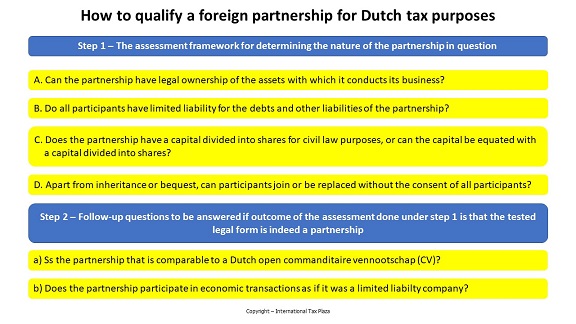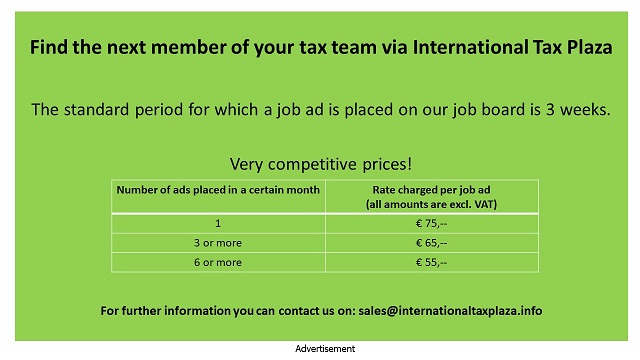Lately several position papers of the Knowledge Group on tax liability & qualification of legal forms of the Dutch tax authorities have been published regarding the question whether in the underlying cases certain foreign partnerships qualify as transparent partnerships for Dutch tax purposes. If such foreign partnership does not qualify as a transparent partnership for Dutch tax purposes then it automatically qualify as a non-transparent partnership or a non-transparent entity for Dutch tax purposes.
In its considerations the Dutch tax authorities have described the steps that have to be taken when assessing how a foreign partnership qualifies for Dutch tax purposes. In this article we discuss these steps, so that our readers get a better understanding on how to assess whether or not a foreign partnership qualifies as a transparent partnership for Dutch tax purposes.
From the considerations of the tax authorities
For Dutch tax purposes foreign legal forms or partnerships must be qualified in accordance with the Decree of December 11, 2009. From this Decree it follows that in order to assess whether the legal form classifies as a limited liability company or as a partnership first an analysis must be made on the basis of the civil law and regulations of the country in question. According to the Decree, in particular four questions are important for this assessment: the so-called assessment framework. In addition to this assessment framework, certainly if a comparable Dutch legal form does not exist, other facts and circumstances may also play a role in determining the nature of the partnership in question.
The initial assessment of the legal form does not look at the specific interpretation given to the relevant partnership in the articles of association or agreement. The qualification is based on the civil law of the country in question. In the event that the relevant (foreign) legislation allows that matters relevant for the qualification are arranged for in statutory provisions, the statutes of the partnership may be important.

Step 1 – The assessment framework for determining the nature of the partnership in question
The assessment framework consists out of the following 4 questions:
Question A
Can the partnership have legal ownership of the assets with which it conducts its business?
This is the case if, under civil law, the partnership can acquire assets and can enter into rights and obligations in the name of the partnership. This also applies if the partnership acquires legal ownership of assets as a result of a registration in the trade register or in a register of a comparable institute, as a result of which the partnership has acquired legal personality.
Question B
Do all participants have limited liability for the debts and other liabilities of the partnership?
In this respect limited liability of a participant means that the liability does not extend beyond the invested capital or the obligation to fully pay-in. In the case of an unlimited liability, the liability is not limited to a fixed amount.
Question C
Does the partnership have a capital divided into shares for civil law purposes, or can the capital be equated with a capital divided into shares?
If the company’s capital is divided into equal or proportionate parts (participations), each entitling to a proportionate share of the profit and liquidations distribution and a proportionate control, the capital will be equated with a capital divided into shares.
Question D
Apart from inheritance or bequest, can participants join or be replaced without the consent of all participants?
On the basis of the legal provisions, the transfer of the participations or the entry or replacement of the participants is generally regulated in the articles of association or by agreement. To answer this question, the articles of association or the agreement must be assessed and tested against the content of the decision of January 11, 2007, no. CPP2006/1869M.
Based on the above assessment framework, it is assessed whether or not a foreign partnership qualifies as a as a transparent body (partnership) or as a non-transparent entity (almost always a limited liability company).
In any case a non-transparent entity in the sense as referred to above exists if:
- if at least three or four questions A through D of the assessment framework have been answered in the affirmative; or
- in cases in which it has been established that the liability of all participants in a partnership is limited to their contribution or the obligation to fully pay-in, the business is legally owned by the partnership and the business is otherwise also not run for the account and risk of the participants (Dutch Supreme Court, June 2, 2006, no. 40,919).
Limited liability companies
In principle, a body constitutes a limited liability company if, on the basis of foreign civil law, the ownership lies with the partnership, all participants have limited liability in the sense referred to above and the capital is divided into shares. In the case of limited liability companies, the agreement is usually drawn up in accordance with mandatory law, but the articles of association can also be completed on the basis of additional law. Limited liability companies are considered to be non-transparent entities.
Partnerships
Partnerships are aimed at the personal cooperation of the participants with a mandatory contribution, whereby the cooperation agreement can be completed according to the wishes of the participants. Under civil law, all participants, but at least one of them, have unlimited liability. From a civil law perspective, partnerships do not have capital divided into shares, but the content of the agreement can be designed in such a way that in fact a capital divided into shares exists.

Step 2 – Follow-up questions to be answered if outcome of the assessment done under step 1 is that the tested legal form is indeed a partnership
If, after testing the criteria included in the assessment framework, the conclusion is that the foreign partnership does not qualify as a non-transparent limited liability company, then in principle it qualifies as a partnership for Dutch tax purposes. However, in that situation it still needs to be assessed whether
(a) whether the partnership is a partnership that is comparable to a Dutch open commanditaire vennootschap (CV) (an (open) limited partnership); or whether
(b) the partnership in the underlying case participates in economic transactions as if it was a limited liabilty company.
If both these questions are answered with 'no', then the partnership is considered transparent for Dutch tax purposes.
Ad a
A partnership is comparable to a Dutch CV if the partnership has the following characteristics.
- A business is run in the name of the partnership.
- There is at least one "general partner" and one "limited partner".
- The general partner is liable to third parties without limitation or for an equal part (as referred to under question B above).
- The limited partner is only internally liable up to a maximum of the capital invested by him.
- The limited partner does not perform any external acts of management and administration.
- The company has no capital divided into shares.
If the partnership is comparable to a Dutch CV, based on Article 2, Paragraph 3, sub c, of the AWR (the General State Taxes Act) it must be assessed whether it concerns an open or a closed CV. If in this case question D is answered in the affirmative, then the partnership is considered a non-transparent partnership (open CV).
Ad b
Finally, if there is a partnership that is not comparable to a Dutch closed CV, then with the help of the answers to questions (C) and (D) and on the basis of the judgment of the Supreme Court of November 24, 1976, no. 17.998, it must be assessed whether the partnership participates in economic transactions as if it was a limited liabilty company. This will generally be the case if the capital invested by the participants can be considered to be divided into shares and these participations are freely transferable. In that case the foreign partnership is considered to be a non-transparent partnership.
If both follow-up questions a and b are answered in the negative, the partnership is considered to be a transparent partnership for Dutch tax purposes.
Copyright – internationaltaxplaza.info
Follow International Tax Plaza on Twitter (@IntTaxPlaza)




